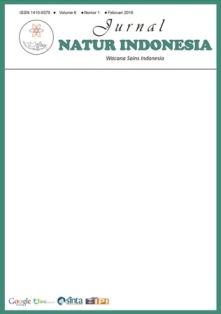Distribution and Clinical Significance of Nuclear Factor Erythroid 2-Related Factor 2 Gene Polymorphism in Chronic Hepatitis B: A Cross-Sectional Study
DOI:
https://doi.org/10.31258/jnat.23.1.10-15Keywords:
polymorphism, NRF2, hepatocellular carcinoma, cirrhosis, Chronic hepatitis BAbstract
Chronic hepatitis B (CHB) infection is associated with serious complications, including liver cirrhosis and hepatocellular carcinoma (HCC). Nuclear factor erythroid 2-related factor 2 (NRF2) is a transcription factor that regulates the expression of antioxidant genes, helping protect cells and tissues from oxidative stress, a process involved in the pathogenesis of chronic hepatitis B (CHB). This study aimed to determine the distribution of NRF2 polymorphisms in CHB patients and their association with complications. The study included 68 CHB patients, with 33 having no complications and 35 with complications (Cirrhosis and HCC). Genotyping of the NRF2 polymorphisms, rs35652124 (A→G) and rs6721961 (C→A), was performed using confronting two-pair primers and polymerase chain reaction (PCR-CTPP). The serum levels of bilirubin, albumin, and alanine aminotransferase (ALT) were measured using commercial kits. The mean age of subjects was 45.34±1.32 years old on average. There was no significant difference in mean bilirubin and ALT levels between patients with and without CHB complications. However, patients without complications had significantly higher albumin levels than those with complications (4.0±0.8 vs. 3.37±0.7 g/dL; p<0.05). The most common genotypes for NRF2 rs35652124 were AG (51.85%), AA (40.74%), and GG (7.41%), while for NRF2 rs6721961, the were CA (51.47%), CC (45.59%), and AA (2.94%). The distribution of NRF2 genotypes did not differ significantly between CHB patients with and without complications (p>0.05). This study suggests that NRF2 gene polymorphisms may not contribute to the development of Cirrhosis and HCC in CHB. Further research with a larger sample size is needed to confirm these findings.
Downloads
References
Akcay, I.M., Katrinli, S., Ozdil, K., Doganay, G.D., Doganay, L., 2018. Host genetic factors affecting hepatitis B infection outcomes: Insights from genome-wide association studies. World Journal of Gastroenterology, 24(30): 3347.
Allameh, A., Niayesh-Mehr, R., Aliarab, A., Sebastiani, G., Pantopoulos, K., 2023. Oxidative stress in liver pathophysiology and disease. Antioxidants, 12 (9): 1653.
Arfianti, A., Sabillah, S.A., Andrini, D.F., Kartika, S.D., Julia P.A., 2021. Genotype distribution of vitamin D receptor polymorphisms among Indonesian patients with chronic hepatitis B. Reports of Biochemistry & Molecular Biology, 9(4):463-469.
Bolukbas, C., Bolukbas, F.F., Horoz, M., Aslan, M., Celik, H., Erel, O., 2005. Increased oxidative stress associated with the severity of the liver disease in various forms of hepatitis B virus infection, BMC Infectious Diseases, (5): 95.
Chen, S., Pan, H., Chen, Y., Lu, L., He, X., Chen, H., Chen, R., et al., 2019. Association between genetic polymorphisms of NRF2, KEAP1, MAFF, MAFK and anti-tuberculosis drug-induced liver injury: a nested case-control study. Scientific Reports, (9): 14311.
Cho, H.-Y., Marzec, J., Kleeberger, S.R., 2015. Functional polymorphisms in NRF2: implications for human disease. Free Radical Biology and Medicine, (88): 362–372.
Çıragil, P., Kurutaş, E. B., Kökoğlu, Ö. F., Aral, M., 2011. Oxidative stress in patients with chronic hepatitis B and C. Balkan Medical Journal, 2011(3): 300-303.
Cleary, S.P., Jeck, W.R., Zhao, X., Chen, K., Selitsky, S.R., Savich, G.L., Tan, T.-X., et al., 2013. Identification of driver genes in hepatocellular carcinoma by exome sequencing. Hepatology (Baltimore, Md.), 58(5):1693–1702.
Duygu, F., Karsen, H., Aksoy, N., Taskin, A., 2012. Relationship of oxidative stress in hepatitis B infection activity with HBV DNA and fibrosis. Annals of Laboratory Medicine, 32(2): 113–118.
Fung, J., Lai, C.-L., Yuen, M.-F., 2014. Management of chronic hepatitis B in severe liver disease. World Journal of Gastroenterology : WJG, 20(43): 16053.
Gnyawali, B., Pusateri, A., Nickerson, A., Jalil, S., Mumtaz, K., 2022. Epidemiologic and socioeconomic factors impacting hepatitis B virus and related hepatocellular carcinoma, World Journal of Gastroenterology, 28(29): 3793.
Ishikawa, T., 2014. Genetic polymorphism in the NRF2 gene as a prognosis marker for cancer chemotherapy. Frontiers in Genetics, (5): 383.
Kalantari, L., Ghotbabadi, Z.R., Gholipour, A., Ehymayed, H.M., Najafiyan, B., Amirlou, P., Yasamineh, S., et al., 2023. A state-of-the-art review on the NRF2 in Hepatitis virus-associated liver cancer. Cell Communication and Signaling, 21(1): 318.
Li, C., Liang, G., Yan, K., Wang, Y., 2024. NRF2 mutation enhances the immune escape of hepatocellular carcinoma by reducing STING activation. Biochemical and Biophysical Research Communications, (698):149536.
Liu, Y., Wu, Q., Zhang, F. and Qin, X., 2023. Antioxidants-related nuclear factor erythroid 2-related factor 2 gene variants associated with HBV-related liver disease. Cancer Cell International, 23(1):72.
McMahon, B.J., 2018. Meeting the WHO and US goals to eliminate Hepatitis B infection by 2030: Opportunities and challenges, clinical liver disease, 12(1):29.
Nahon, P., Zucman-Rossi, J., 2012. Single nucleotide polymorphisms and risk of hepatocellular carcinoma in Cirrhosis, Journal of Hepatology, 57(3): 663–674.
Santos, K.N.D., Florentino, R.M., França, A., Lima Filho, A.C.M., Santos, M.L.D., Missiaggia, D., Fonseca, M. de C., et al., 2019. Polymorphism in the promoter region of NFE2L2 gene is a genetic marker of susceptibility to Cirrhosis associated with alcohol abuse. International Journal of Molecular Sciences, 20(14): 3589.
Shimoyama, Y., Mitsuda, Y., Tsuruta, Y., Hamajima, N., Niwa, T., 2014. Polymorphism of NRF2, an antioxidative gene, is associated with blood pressure and cardiovascular mortality in hemodialysis patients. International Journal of Medical Sciences, 11(7): 726–731.
Tang, W., 2014. Role of NRF2 in chronic liver disease, World Journal of Gastroenterology, 20(36): 13079
Trépo, C., Chan, H.L.Y., Lok, A., 2014. Hepatitis B virus infection, Lancet (London, England), 384(9959): 2053–2063.
Yamaguchi, Y., Kamai, T., Higashi, S., Murakami, S., Arai, K., Shirataki, H., Yoshida, K.-I., 2019. NRF2 gene mutation and single nucleotide polymorphism rs6721961 of the NRF2 promoter region in renal cell cancer. BMC Cancer, (19):1137.
Yano, Y., 2015. Hepatitis B virus infection in Indonesia. World Journal of Gastroenterology, 21(38): 10714.
Downloads
Published
Issue
Section
License
Copyright (c) 2025 Vitriyanna Mutiara Yuhendri, Magda Labecka, Sundus Ibrahim, Arfianti Arfianti (Author)

This work is licensed under a Creative Commons Attribution 4.0 International License.





